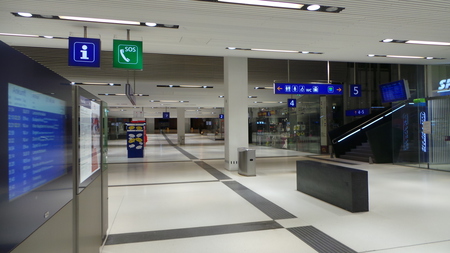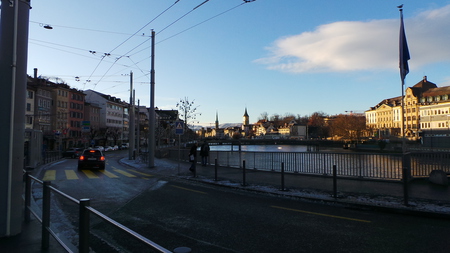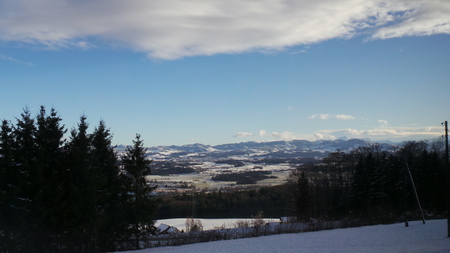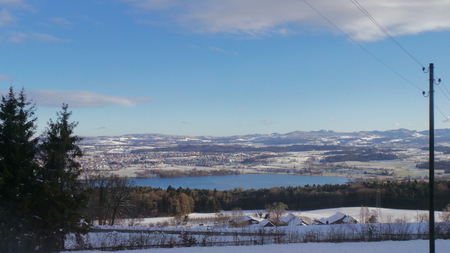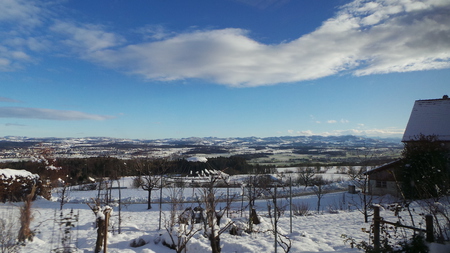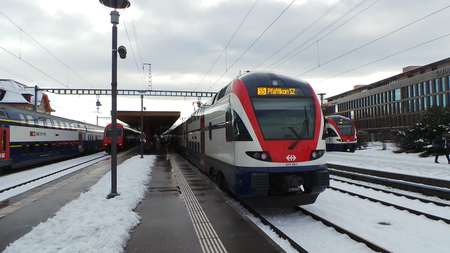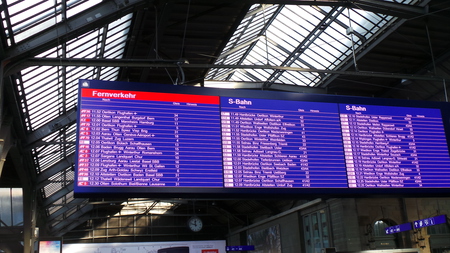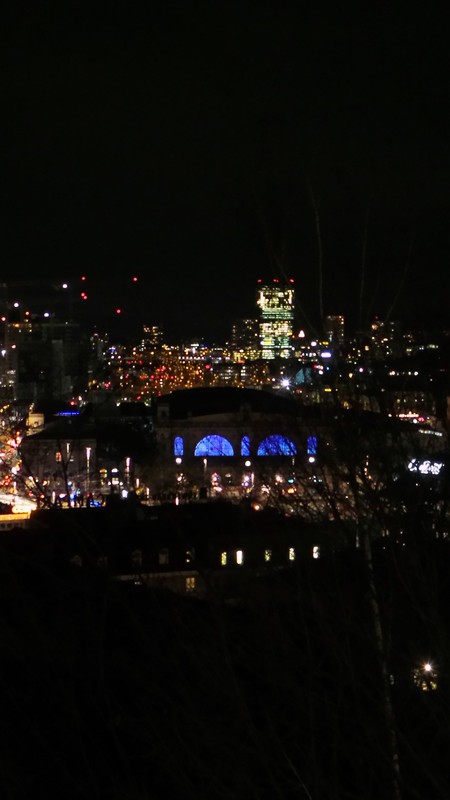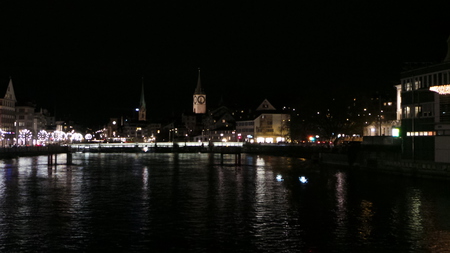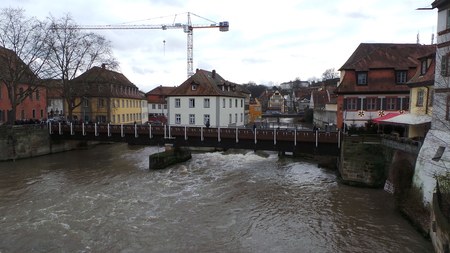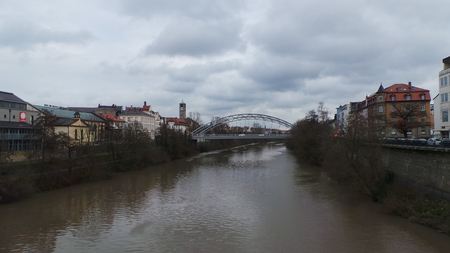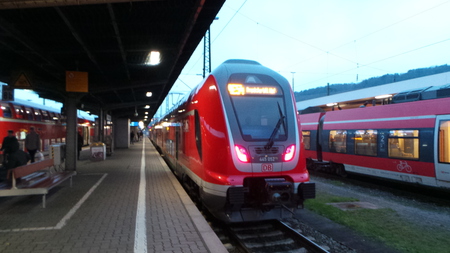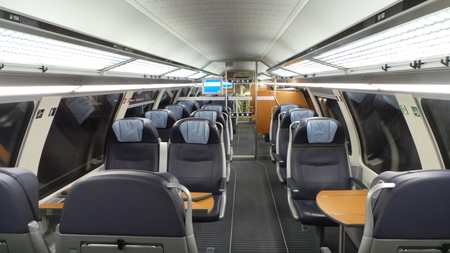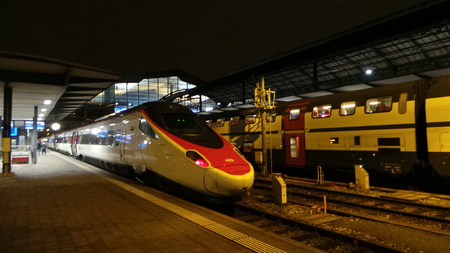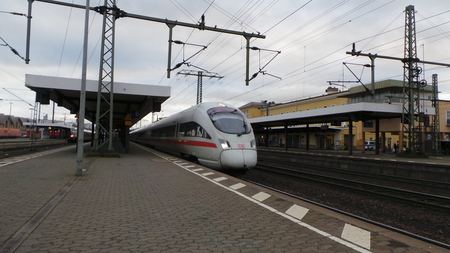Hi together and happy holidays,
two weeks ago the VDE8 (Verkehrsprojekt Deutsche Einheit, project for German unity) was introduced into regular service - not without typical german problems: delays and cancellations took place, caused by winterly weather and malfunctions in the ETCS-system. Now the traffic is running well.
I used this two weeks to travel a little, and take some old and new impressions.
10th december (day of the new schedule):
After a date in Munich I waited for the 3.24-ICE to Dortmund, to get home to Braunschweig. This was a lucky coincident, so I reached Munich in the old, and left it in the new timetable-period.

1. Next to the information to the reconstruction of Munich main station, there was an information for the new VDE8 (in public communication provided as high-speed-line Berlin-Munich).

2. Due to the time, I had to spend in Munich until 3.24am I visited some POIs, e.g. this one: monument to the king Maximilian II. of Bavaria.
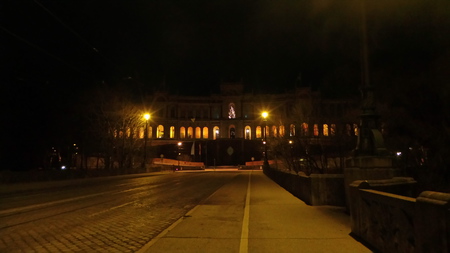
3. On the opposite Isar bank there is the Maximilianeum, also named after Max II. and today seat of the bavarian parliament (Landtag).
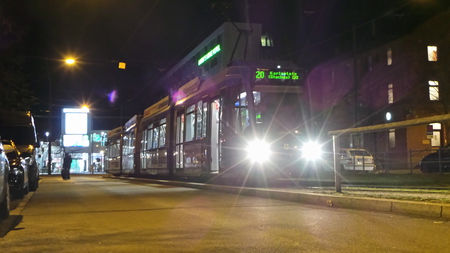
4. The Munich tram system was also affected by the new timetable. Here we can see an older vehicle (R3, from 2000) in Moosach.
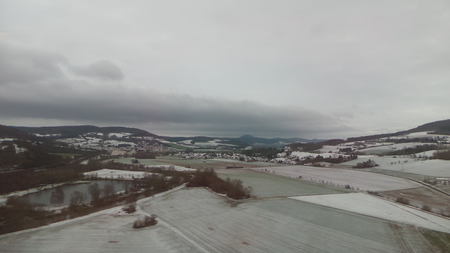
5. After changing the train in Mannheim, I had a nice view from the 1.400 m long Fulda-valley-bridge near Morschen.
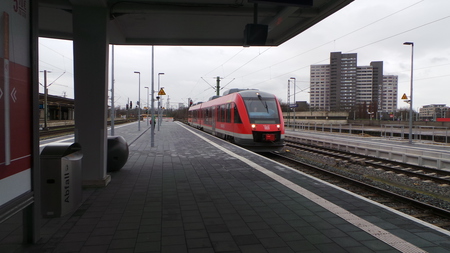
6. In Braunschweig the last regular RB44-service with LINT41-trains arrives at the main station. Since introduction of the new half-hourly-service (RB44/RB48) it is intended to serve this line to Salzgitter with shorter LINT27-trains...

7....which we can see here in Salzgitter-Lebenstedt. The trains are equipped with WiFi and sockets to charge the phone during the ride.
13th december 2017
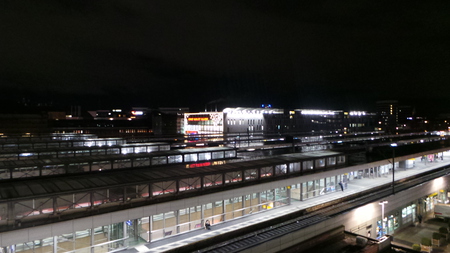
8. Next tour is going to the new VDE8-route. This picture shows the Hannover main station.
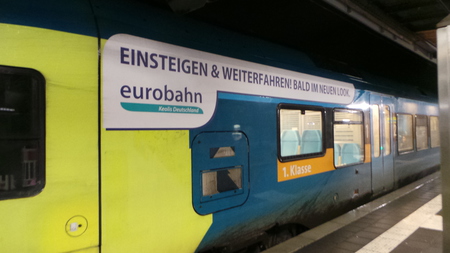
9. In local traffic there were some new operation contracts as in the TWN, where the SNCF-daughter Keolis won several lines in central and eastern Westphalia and one international line to Hengelo in the Netherlands. Most of the trains were just overhanded to Keolis, where they will get a redesign in the following months. For now, the announcement, you see here, is most everything information about the changings: "enter and continue! Soon in a new look".
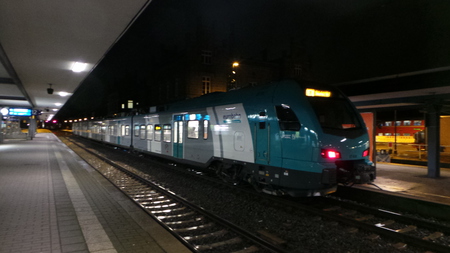
10. For the service Bielefeld - Hengelo Keolis ordered eight new FLIRT3-EMUs, which also run under dutch current (sorry for the quality, my camera works not well in the dark).

11. This is the interior, all Keolis trains will get in the future.
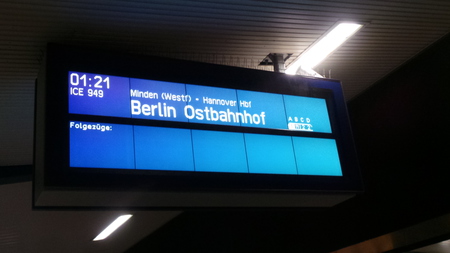
12. Another change is, that the night-service Köln - Berlin changed from IC- to ICE-material, and got new numbers (948/949 instead of 446/447).
14th december 2017
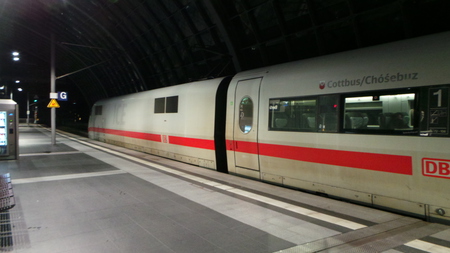
13. The next morning in Berlin. The ICE949 has arrived at the main station, where I will change for the Sprinter-train to Munich.
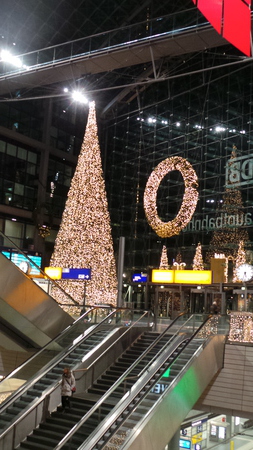
14. Christmas mood.

15. 6.02, ICE1001 to München Hbf. Travel time: 4h02m. Distance: 618 km.

16. View from the Itztalbrücke near Coburg between Erfurt and Nuremberg.
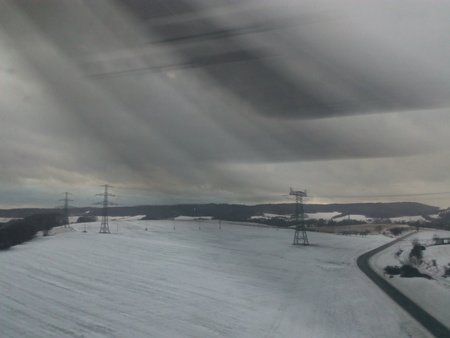
17. In this region there was snow at that time.

18. Munich was reached with a 34-minute-delay.
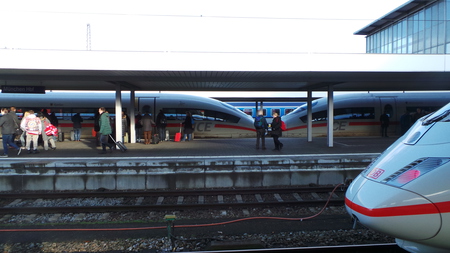
19. Double ICE-train to Essen, in the background EC to Prague.

20. One of the two premier-trains, recognizable by the signs of passengers on the new VDE8. Above is written: "this is your route...".
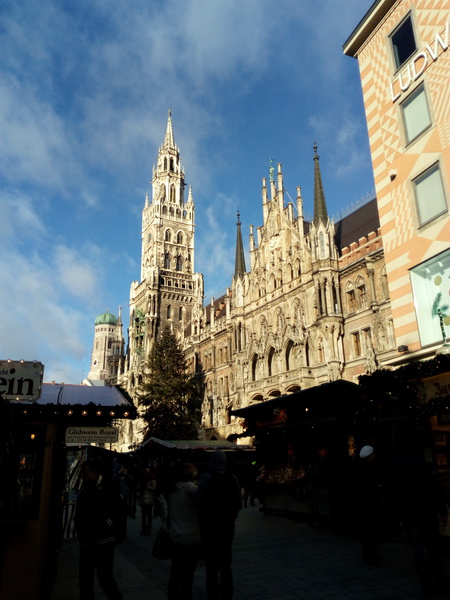
21. A short visit in Munich city centre: Marienplatz with City Hall.

22. And the Karlstor (Karl's Gate).
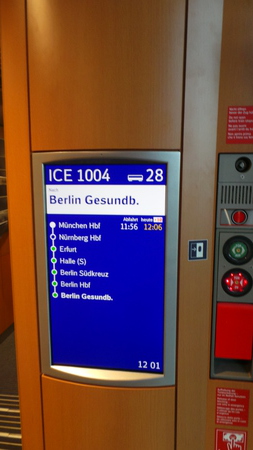
23. The redesigned ICE3-trains got new displays in the entrance area to inform the passengers as good as possible. All displays show alternately the course of the train in the showed form, as well as on a map. And before arriving at the next station, it also shows connecting services with real-time-information.
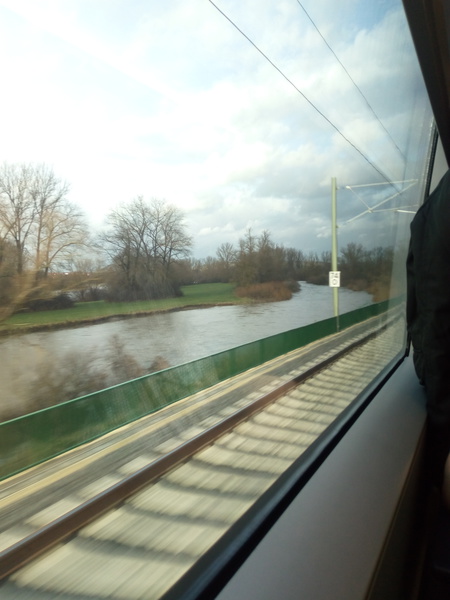
24. North of Bamberg the river Main is running directly along the railroad.
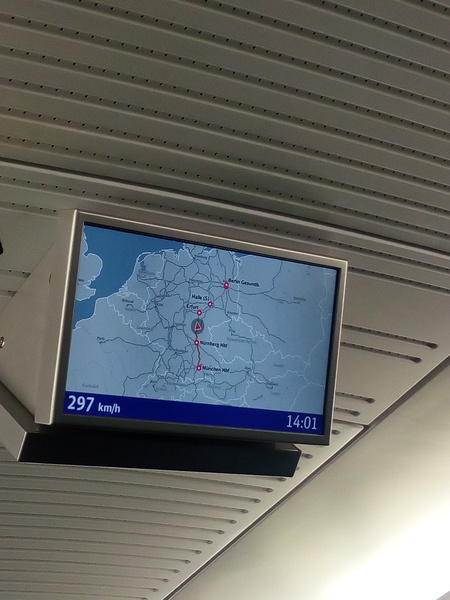
25. Between Nuremberg and Erfurt the line crosses the Thüringer Wald, a mountain range, so first it's a- and later descending, which also means, that the highest possible speed usually is reached behind the vertex.
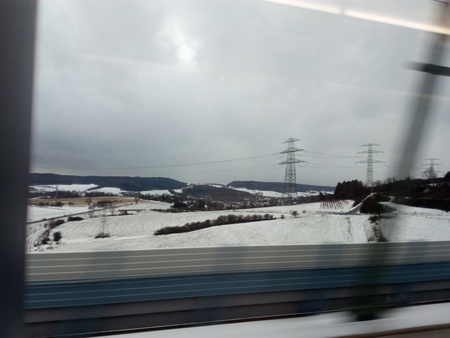
26. One of the few possibilities for a good view between the countless number of tunnels.

27. Later between Erfurt and Halle, the train reaches the 300 kmh for the first time, after pushing against the 299-kmh-mark again and again. It was quite frustrating for the viewer.
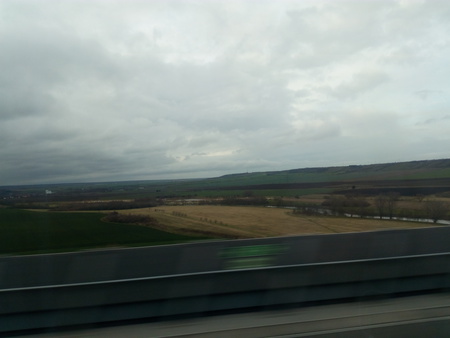
28. The longest bridge on this section - exept the Saale-Elster-viaduct - is the 2.6 km long Unstrut-valley-bridge in the more flat part of the country.

29. The redesigned trains has new seats, which are also built-in in the new ICE4-trains. Instead of installing the reservation-information in the luggage rack, they are on the seats themself.
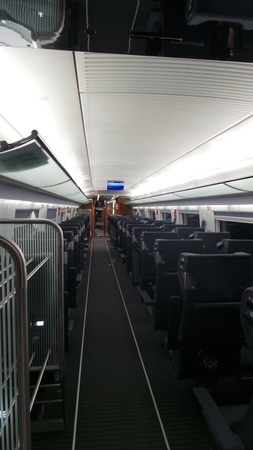
30. First class coach.
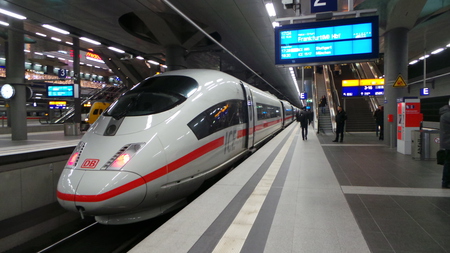
31. After reaching Berlin, the train is proceeding to Frankfurt. Because of the maintenance of ICE3-trains in Frankfurt, the Berlin-Munich-services have to be connected to some services to Cologne and Frankfurt, which is possible by using the lines 10 (Berlin - Köln), 15 (Berlin - Frankfurt) and 41/42 (München - Köln).
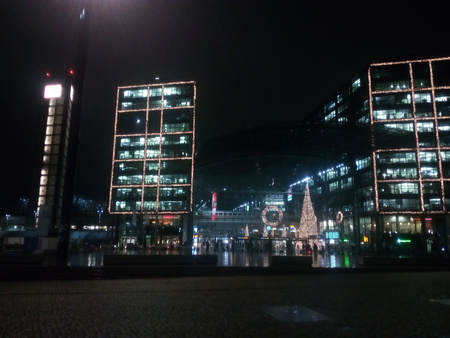
32. The 11-year-old Berlin main station from the outside.
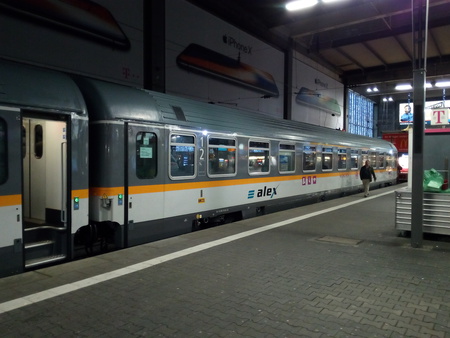
33. Back in Munich: to provide an adequate number of seats, the private operator alex hat to buy some coaches of the italian state-railway. alex is operating services from Munich to Oberstdorf, the Lake Constance, Hof and Prague, each two-hourly.
The second part is following...
two weeks ago the VDE8 (Verkehrsprojekt Deutsche Einheit, project for German unity) was introduced into regular service - not without typical german problems: delays and cancellations took place, caused by winterly weather and malfunctions in the ETCS-system. Now the traffic is running well.
I used this two weeks to travel a little, and take some old and new impressions.
10th december (day of the new schedule):
After a date in Munich I waited for the 3.24-ICE to Dortmund, to get home to Braunschweig. This was a lucky coincident, so I reached Munich in the old, and left it in the new timetable-period.

1. Next to the information to the reconstruction of Munich main station, there was an information for the new VDE8 (in public communication provided as high-speed-line Berlin-Munich).

2. Due to the time, I had to spend in Munich until 3.24am I visited some POIs, e.g. this one: monument to the king Maximilian II. of Bavaria.

3. On the opposite Isar bank there is the Maximilianeum, also named after Max II. and today seat of the bavarian parliament (Landtag).

4. The Munich tram system was also affected by the new timetable. Here we can see an older vehicle (R3, from 2000) in Moosach.

5. After changing the train in Mannheim, I had a nice view from the 1.400 m long Fulda-valley-bridge near Morschen.

6. In Braunschweig the last regular RB44-service with LINT41-trains arrives at the main station. Since introduction of the new half-hourly-service (RB44/RB48) it is intended to serve this line to Salzgitter with shorter LINT27-trains...

7....which we can see here in Salzgitter-Lebenstedt. The trains are equipped with WiFi and sockets to charge the phone during the ride.
13th december 2017

8. Next tour is going to the new VDE8-route. This picture shows the Hannover main station.

9. In local traffic there were some new operation contracts as in the TWN, where the SNCF-daughter Keolis won several lines in central and eastern Westphalia and one international line to Hengelo in the Netherlands. Most of the trains were just overhanded to Keolis, where they will get a redesign in the following months. For now, the announcement, you see here, is most everything information about the changings: "enter and continue! Soon in a new look".

10. For the service Bielefeld - Hengelo Keolis ordered eight new FLIRT3-EMUs, which also run under dutch current (sorry for the quality, my camera works not well in the dark).

11. This is the interior, all Keolis trains will get in the future.

12. Another change is, that the night-service Köln - Berlin changed from IC- to ICE-material, and got new numbers (948/949 instead of 446/447).
14th december 2017

13. The next morning in Berlin. The ICE949 has arrived at the main station, where I will change for the Sprinter-train to Munich.

14. Christmas mood.

15. 6.02, ICE1001 to München Hbf. Travel time: 4h02m. Distance: 618 km.

16. View from the Itztalbrücke near Coburg between Erfurt and Nuremberg.

17. In this region there was snow at that time.

18. Munich was reached with a 34-minute-delay.

19. Double ICE-train to Essen, in the background EC to Prague.

20. One of the two premier-trains, recognizable by the signs of passengers on the new VDE8. Above is written: "this is your route...".

21. A short visit in Munich city centre: Marienplatz with City Hall.

22. And the Karlstor (Karl's Gate).

23. The redesigned ICE3-trains got new displays in the entrance area to inform the passengers as good as possible. All displays show alternately the course of the train in the showed form, as well as on a map. And before arriving at the next station, it also shows connecting services with real-time-information.

24. North of Bamberg the river Main is running directly along the railroad.

25. Between Nuremberg and Erfurt the line crosses the Thüringer Wald, a mountain range, so first it's a- and later descending, which also means, that the highest possible speed usually is reached behind the vertex.

26. One of the few possibilities for a good view between the countless number of tunnels.

27. Later between Erfurt and Halle, the train reaches the 300 kmh for the first time, after pushing against the 299-kmh-mark again and again. It was quite frustrating for the viewer.

28. The longest bridge on this section - exept the Saale-Elster-viaduct - is the 2.6 km long Unstrut-valley-bridge in the more flat part of the country.

29. The redesigned trains has new seats, which are also built-in in the new ICE4-trains. Instead of installing the reservation-information in the luggage rack, they are on the seats themself.

30. First class coach.

31. After reaching Berlin, the train is proceeding to Frankfurt. Because of the maintenance of ICE3-trains in Frankfurt, the Berlin-Munich-services have to be connected to some services to Cologne and Frankfurt, which is possible by using the lines 10 (Berlin - Köln), 15 (Berlin - Frankfurt) and 41/42 (München - Köln).

32. The 11-year-old Berlin main station from the outside.

33. Back in Munich: to provide an adequate number of seats, the private operator alex hat to buy some coaches of the italian state-railway. alex is operating services from Munich to Oberstdorf, the Lake Constance, Hof and Prague, each two-hourly.
The second part is following...
